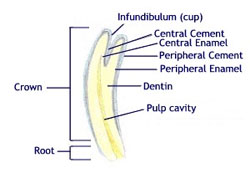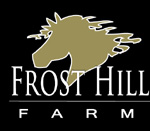cementum
dentin
enamel
Cementum is the outer layer of the
tooth. The periodontal ligament is attached
to the cementum anchoring the tooth to the surrounding
bone.
Dentin makes up most of the tooth substance. It
surrounds the enamel giving strength to the tooth.
Enamel is the strongest substance in the body, but
is brittle when compared to dentine.
Cementum, dentin, and enamel wear at
different rates, producing irregular and rough tooth
surfaces that are capable of crushing very tough food
material.
How Horses Chew
Horses do not chew as people do. They
grind their food by sliding their teeth side to side. The
horse opens its mouth slightly and moves the jaw to one
side. As the mouth closes the chewing surfaces
shear off or grind their food. They chew on one side
of the mouth at a time. As the jaw returns to the
resting position the chewing surfaces separate. When
the front teeth, or incisors are in contact, there
should be no contact between the upper and lower molars.
Horses chew in this manner because of the anatomy
of their mouth. The upper molars are set wider
apart than the lower molars. There is little
overlap of the teeth surfaces. Therefore, chewing
in the way that humans do, would have little affect
on their food. This grinding motion causes the
surface of the teeth wear at a 15 degree angle.
Poor Dental Health
Malocclusion is bad contact between
the teeth. Horses
can have incisor and/or molar malocclusions. Either
type may interfere with grasping or chewing food and
performance. Long standing malocclusions usually
result in premature loss of teeth.
Exaggerated traverse ridges are tall
with sharp points on top. They interfere with
normal chewing and jaw motion front to back.
Symptoms of Tooth Problems
Canine tooth problems
Tartar, especially around the canines and the incisors'
gumline. This should be removed to avoid gum infections.
Canines can also get fractured.
Decay and endodontic disease - caries
Decay as we see it in humans rarely occur in the horse.
This is probably due to the anatomy of the horses tooth
and its ability to produce secondary dentin to fill
in cavities.
Failure of enamel development
Fractures/sequestrums
Fractures to skull bones
Oral trauma from bit being pulled too hard or reins being stepped on can cause
a part of the jaw bone to be chipped off, this usually won't grow back in place
but will instead be sequestered and lie in the same spot to get inflammed and
painful, and hard pull on the bit or step on the reins can also seriously damage
the tongue. A sequestrum like this should be removed surgically.
Fractures to teeth
Horses falling over, being kicked or banging their heads against something can
fracture teeth easily. Clipping of canine teeth and cutting molars can also cause
fracture with later infections to the root and surrounding tissues. Wolf teeth
being broken off during extraction is something that is not unusal, but it rarely
causes any problems as the remains will dissolve and be taken care of by the
body.
Maleruption
Due to injury, teeth buds can have moved to abnormal places
Missing teeth
As described in the section of molar and incisor problems, missing teeth can
be caused by and/or will lead to dental and periodontal disease in the horse.
The loss of a tooth can be caused by trauma, it can be genetic or it might be
due to periodontal disease.
Pain in the chewing (masticatory) muscles
There are very powerful muscles that makes it possible
for the horse to move its lower jaw sideways and
to close the mouth (chew). There are conditons that
can make these muscles very sore. Myositis is a condition
of inflammation of muscles.
Periodontal disease
Disease in the tissues surrounding and supporting the
teeth crown and reserve crown is called periodontal
disease. It is caused by infection and inflammation,
often because for some reason feed has been allowed
to pack into a pocket around the tooth or next to
a tooth because of misalignment, missing teeth etc.
Periodontal disease can lead to a large number of
problems with infections, pain, sinusitis, chewing
problems and tooth loss
Problems in the temporo-mandibular joint
(TMJ)
Prolapse, arthritis, arthrosis, inflammation and pain
This is a very underestimated problem in the horse
and it is very painful. It can cause problems with
chewing and being ridden and general behaviour alterations
due to the pain. It can be caused by misalignments
of the teeth pushing the joint to an unnatural position,
it can be caused by a mouth speculum being kept on
for too long or in a wrong way, it can be caused by
misfitted tack or a rough rider/driver..................
Constant Arthritis can lead to degenerative changes
in the joint (artrosis)
Sinusitis
The anatomy of the head makes the connection between
the molars and the sinuses quite intimate. An infected
root and sinusitis has...........The signs of sinus
infection can be swelling and pain of the face, nasal
discharge (normally just from one nostril) and ..................It
is usually treated with antibiotics, but if this
is unsuccessful more serous measures will be made.
Making a hole in the sinus from the outside of the
scull (trephan...) and flushing the sinuses with
saline water is one solution, but if the rooth infection
can't be cured in any of these ways, tooth extractions
may be a necessity.
Supernumerary teeth
Too many teeth in the mouth is usually caused by the
teeth buds splitting in by trauma in the foetal development.
It can also be genetic.
Tartar
The buildup of tartar around the teeth by the gumline is a potential problem
as it can provide conditions for bacterial growth. In the horse this is mainly
a problem around the canine tooth.
Tongue injuries
In some sports, especially harness racing, it is very
common to use a tongue tie around the horse's tongue
to prevent it from sliding back during racing and
preventing airflow. Forgetting to remove a tongue
tie after racing may seriously damage the tongue.
The horse can also inflict trauma on itself in the
mouth ie by getting the tongue in the way of the
teeth causing wounds, ulcers or in the worst case
I have seen a tounge being bitten off completetly.
Tumours
There are a variety of tumours that can be found in
the mouth of the horse and it can originate from
different tissues. Some are benign, others malignant. Some
examples are: Melanomas, Squamous cell carcinomas.
Ulcers
Because the equine teeth forms such sharp edges and
points, the soft tissues in the mouth
Wolf tooth problems
Apart from the problem the wolf teeth can cause for
using being sharp when soft tissue is pressed against
it, there are also other problems they can cause.
If they are present, but haven't erupted yet (blind),
they can cause painful swellings (unerupted) on the
bars and/or they can be situated in an abnormal place,
all causing bitting problems due to pain. Fractures
also occur, but this seldom makes any trouble as
the fragements in time will be absorbed.
Other
Other painful dental or oral disorders or systemic
disorders manifesting in the mouth. Infections, wounds,
inflammation, tumours etc
Dental Care
Equine dentistry is evolving from just floating to
performance dentistry. Interest of horse owners,
trainers, and veterinarians have furthered studies
on how the mouth functions and how dental problems
affect performance. Simply removing sharp molar
points may not eliminate all the sources of oral
pain. Horses experiencing oral pain will not
perform to their full ability.
Floating is done to make the surface
of the horse's tooth level or smooth. This is
accomplished by the removal of sharp points on the
outer edge of upper molars and inner edge of lower
molars.
Performance Dentistry includes a floating,
comprehensive oral examination, identification and
correction of incisor and molar malocclusions, and
tooth shaping. Tooth shaping of certain molars
to prevent soft tissue damage, which cause oral pain,
is an important part of performance dentistry
| 


